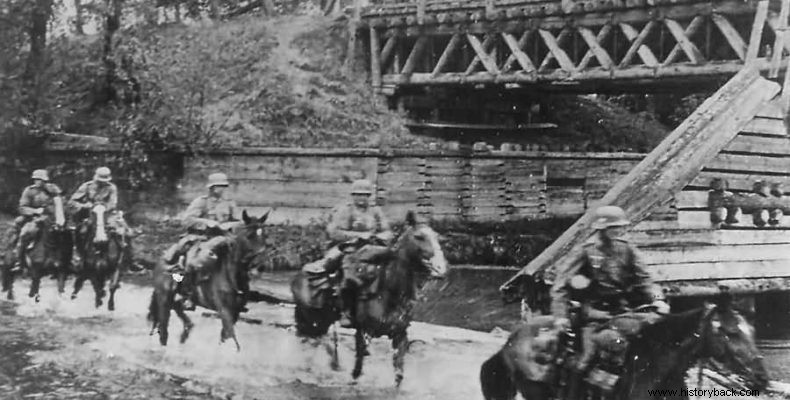
When World War II broke out, on 1 September 1939 two Cavalry Regiments joined the newly formed Cavalry Brigade (TI). Other cavalry regiments were disbanded and their divisions distributed to other formations.
TI extended the 1st and 2nd SI, with the above composition. In addition to the two regiments, the TI had a bicyclist "heliarchy" of three columns, each with 195 men, four MG-34s on tripods, nine identical guns on bipods, and three 50mm light mortars. It also had a heavy armament of three 37mm A/T guns, four 75mm light howitzers and six 81mm mortars.
The TI also had a mounted artillery squadron, with two artillery companies, each with four 75mm guns, anti-tank artillery with 12 37mm A/T guns, and anti-aircraft artillery with 12 20mm guns.
The TI had an additional organic Engineer company and an organic Transmission company, two motorized and two mounted supply and transport detachments, a motorized fuel transport detachment, a repair platoon, a supply platoon, a motorized medical detachment and an ambulance platoon, and a veterinary platoon.
The total strength of the TI was 6,684 men, 4,552 horse, 409 chariots, 427 vehicles, six armored vehicles, 153 basket motorcycles and 165 simple motorcycles. Later, Ranzerbuchse 39 anti-tank rifles were also made available, in the proportion of two rifles per cavalry or cyclist unit.
With this composition the TI received its baptism of fire in Poland under the command of Colonel Kurt Feld. The TI was deployed on the left flank of the German 3rd Army in East Prussia. The TI moved with the vanguard of the 1st SI, crossing the German-Polish border, encountering no appreciable resistance. TI's first objective was the town of Misenice. The town was taken after a bombardment by the organic artillery and mortars of the brigade.
A little later, however, German and Polish horsemen clashed in one of the few horse battles of World War II (WWII). In this conflict, horsemen of the 1st SI faced Poles of the 11th Ulan Regiment of TI "Mazowiecka". A patrol of the 11th Ulan, under Lieutenant General Władysław Kosakowski spotted a German patrol and attacked it. At first the Germans panicked. But soon the rival horsemen were engaged in a confused conflict with every available weapon. They finally separated without a decisive result being achieved, with losses on both sides.
On September 3, outside the small town of Frankovo, German horsemen engaged in horse combat with men of the Polish 7th Wlan Regiment. This time the Germans, engaging their entire force, prevailed, repelling at the same time a daring Polish attack on the TI command post.
The TI then moved southeast and on 5 September reached the Naref River and crossed it first as the vanguard of the 3rd Army. The TI was officially subordinated to the 12th MP and continued its attack. But he was under serious Polish attack and was hard pressed. The German horsemen fought exceptionally well as infantry and with difficulty, if at all, repulsed the enemy attack.
After the Narev Crossing the TI undertook reconnaissance missions, covering the overextended German line as the bulk of German forces were concentrated against Maudlin's Polish Army. The TI continued to flank the 3rd Army until the Polish formation had disintegrated, between 8-14 September.
Nevertheless, Polish pockets of resistance still existed. On September 23, another classic type horse battle took place between the Germans and the Polish 25th Wlan Regiment. In this conflict the two opponents collided with spears and swords, from the cluster. The Poles prevailed and moved against the TI positions, only to be slaughtered by the German machine guns deployed.
The TI did not undertake another serious mission until the end of the Polish campaign. However, the MP mounted reconnaissance teams also played a major role in this campaign. Corporal Horms was also a member of one of them.
"After an hour's rest we moved again. The following infantry were cursing us because our horses were kicking up a lot of dust on the dirt road we were moving on. We were going up a hill. It was already getting dark. I was angry because we were ordered to move at a rolling speed. My horse, "Baron", couldn't take it anymore. I spoke to the head of the conspiracy. My horse can't take it anymore, I told him. At the same time the suffering horse fell to its knees. We had traveled 70 km on the first day and 60 km on the second and about the same on the third day"...
The Cavalry played a decisive role in the neutralization of "Team Hubal". This group of Polish soldiers who had escaped the disaster had gathered around a nucleus of the 10th Ulan Regiment, under Major General Henryk Dobratski (alias Hubal). This group continued to fight, gradually reinforced by survivors of other units and insurgents, until May 30, 1940, that is, seven months after the official end of the campaign.
Cavalry, due to the terrain and the lack of a road network, could move where motorized vehicles could not. Infantry could of course move everywhere, but at a much slower pace than cavalry. Thus the cavalry assumed the main role in the pursuit of the Poles, until their extermination, at Kielce.
